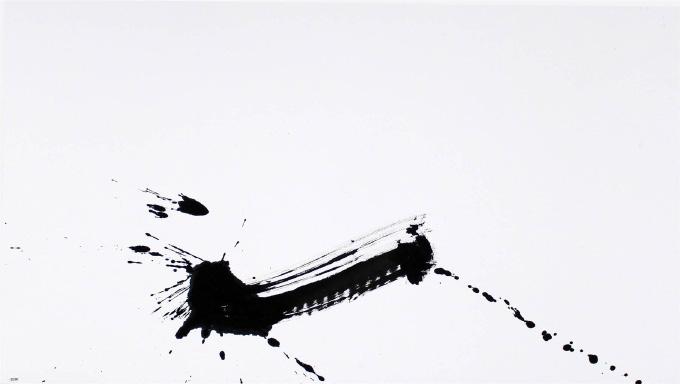Hiroshi Wada’s black and white Japanese ink drawings on rice paper are a vibrant union between the familiar and enigmatic, and an intriguing divergence between the past and present. Reminiscent of “shodo,” traditional Japanese calligraphy, Wada’s artwork respectfully breaks the time barrier of this ancient art with modern zeal. Artwork by 20th-century action painter and calligrapher Yuichi Inoue, fifteen years of study with contemporary calligrapher Ryosetsu Imai, and the artist’s early track and field training informed his practice and process. Wada is scripting his own creative and communicative path with powerful speed, leaping with confidence into the current post-modern era.
Wada’s imagery leaves the written language of his ancestry and catapults into fluid brushstrokes and assertive mark making of abstracted form. In his Kyoto, Japan studio, the artist’s hand sweeps across the substrate, branding expressionist shapes that seem to dance in the shadows of nature, architecture and humanity. Wada, ignited by a clear vision, aims to illuminate the oneness in the physical world and engender a conversation about the spirit of global peace.
 HIROSHI WADA ON
HIROSHI WADA ON




Great



 WAY_05, 2019
Japanese Calligraphy on Paper
WAY_05, 2019
Japanese Calligraphy on Paper



 SNOW_01, 2020
Japanese Calligraphy on Paper
SNOW_01, 2020
Japanese Calligraphy on Paper



“Sho,” for which I aim, is not what is known as traditional Japanese “sho,” but a modern “sho” that matches any scene in the world. Moreover, it is not avant-garde calligraphy, formative art with Indian ink, but rather it is an entirely new one. While it does contain the aforementioned elements, it is more readable, and comprehensible as characters, yet written with polished lines of “sho” which is called the “art of lines.”

ORIGINAL HIROSHI WADA ARTWORKS ON
For inquiries, sales@agora-gallery.com

